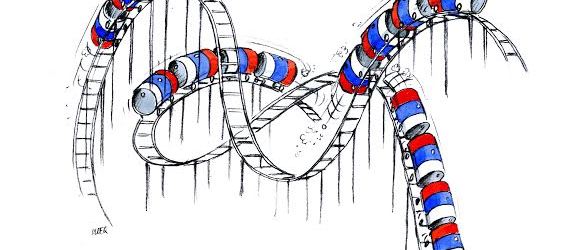
Happy New Year!
During all the years that I have worked with Peak Oil I have always asserted that the price of oil will be what the market is willing to pay. When we held our first Peak Oil conference in Uppsala in 2002 the price was around $25 per barrel. At that time, a price over $50 per barrel would have been regarded as shocking. In September 2004 when I was at a conference in Abu Dhabi the price did pass $50 per barrel. Radio and TV stations phoned me and wanted me to comment – even the BBC called. Now, a decade later, it is shocking when the price has fallen below $50 per barrel. Six years ago we saw a similar price crash to what we have experienced during the final months of last year. At that time, it took some months before the price began to rise again. A decisive factor is that production in existing conventional crude oil fields is falling by 6% per year. Conventional crude oil production is currently around 78 million barrels per day. Thus, production from existing fields will fall by around 2 million barrels per day during the first four months of this year. The currently low oil price means that industry is unlikely to invest in new production so, in half a year, a proportion of the current level of overproduction should be offset by declining production from conventional oilfields. We can also expect to see a decline in shale oil production in the USA until the price is once again over $80 per barrel. A negative effect of the current decline in the oil price is that investment in more expensive renewable energy sources is postponed.
Gott Nytt År!
Under alla år som jag jobbat med Peak Oil har jag konsekvent sagt att priset på olja blir vad marknaden är villig att betala. Då vi hade vår första Peak Oil konferens i Uppsala 2002 var priset runt 25 dollar per fat och ett pris över 50 dollar per fat var då chockerande. I september 2004 var jag på en konferens i Abu Dhabi och då passerade priset just 50 dollar per fat. Radio och TV ringde och ville ha min kommentar, ja till och med BBC. Nu tio år senare är det chockerande att priset har sjunkit ner mot 50 dollar per fat. För sex år sedan hade vi samma prisras som vi haft under hösten och då tog det några månader innan priset började att stiga på nytt. En avgörande faktor är att produktionen i existerande råoljefält sjunker med 6 procent om året och denna produktion är runt 78 miljoner fat om dagen. Det betyder att denna produktion kommer att minska med 2 miljoner fat om dagen under de kommande 4 månaderna. Med det låga pris som vi nu har kommer industrin inte att investera i nu produktion så om ett halvår bör en del av dagens överproduktion vara uppäten. Vi kan också förvänta oss en nedgång i skifferoljeproduktionen i USA tills priset på nytt är uppe vid 80 dollar per fat. En negativ faktor vad det gäller oljeprisets bergodalbana är att satsning på dyrare förnybar energi skjuts upp.

Dan Gunnemark
January 7, 2015
“78 miljoner fat om året” – det ska väl vara 78 miljoner fat per dag?
aleklett
January 8, 2015
Självklart